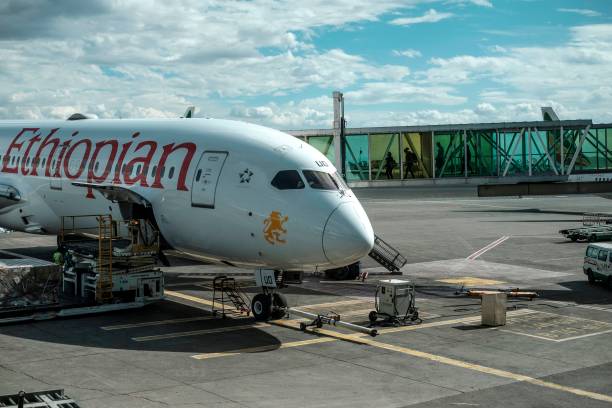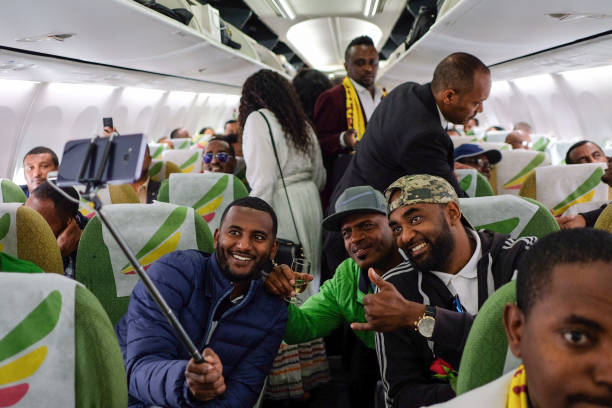Ethiopia’s Mega-Airport Ambition: Building Africa’s Largest Aviation Hub

Ethiopia is embarking on an unprecedented infrastructural leap: the construction of a mega-airport city near Bishoftu, approximately 40–45 km southeast of Addis Ababa. Spearheaded by Ethiopian Airlines in collaboration with the African Development Bank (AfDB), this project is poised to transform Ethiopia into Africa’s premier air travel and logistics hub. Announced in late 2024 and actively progressing through 2025, the estimated US $6–7.8 billion project aims for completion by 2029, with full buildout expected by 2040. Upon completion, the airport is projected to serve up to 110 million passengers annually, significantly surpassing the capacity of Bole International Airport, which currently handles around 25 million.

SOURCE: gettyimages
Background and Strategic Drivers
Ethiopian Airlines carried 17 million passengers in the 2023/24 fiscal year, with projected growth to 20 million in 2025. This reflects a robust expansion under its Vision 2035 strategy. That roadmap targets 65 million annual passengers, the doubling of the current fleet, and a substantial extension of the airline’s global network, aiming to serve over 200 international destinations.
To support this scale of operations, Bole International Airport—already operating near its capacity—can no longer provide the space or efficiency required. The new airport project was originally conceived in 2018, but momentum accelerated in 2024 following formal contracts with Dar Al‑Handasah Consultants, in partnership with Zaha Hadid Architects and Sidara. By March 2025, Ethiopian Airlines and the African Development Bank signed a letter of intent to fund and oversee the project, marking a critical step in turning the vision into reality.
Project Scope and Design Features
The airport is envisioned as a self-contained mega-airport city. It will include over 1.1 million square meters of passenger terminal space, 126,000 square meters of airline support infrastructure, and approximately 100,000 square meters allocated to cargo and logistics services. The final design will accommodate 270 aircraft aprons and four runways, with the goal of servicing more than 100 million passengers per year.
The development will occur in two primary phases:
Phase 1 (targeted for 2029):
Two operational runways, a partial terminal complex, and a capacity for 60 million passengers.
Phase 2 (to be completed by 2040): Two additional runways, expanded terminals, and full integration of ancillary facilities including hotels, retail centers, offices, and cargo hubs.
One notable strategic advantage of the Bishoftu location is its lower elevation—approximately 1,800 meters above sea level—compared to Bole Airport’s 2,334 meters. This offers improved fuel efficiency and payload performance for aircraft operations.
Economic and Strategic Significance
Aviation Leadership
The project aims to cement Ethiopia’s position as a dominant force in African aviation. Ethiopian Airlines is already Africa’s largest airline by revenue and operational reach. With the completion of this new airport, the airline will be positioned to directly connect long-haul destinations such as the United Kingdom, Saudi Arabia, India, and the United States. This will reduce reliance on traditional transit hubs like Istanbul, Doha, or Dubai, and strengthen Addis Ababa’s role as a key global gateway.
Job Creation and National Development

SOURCE: gettyimages
The construction and eventual operation of the airport are expected to generate tens of thousands of direct and indirect jobs. These range from construction and engineering roles to aviation services, hospitality, retail, logistics, and administration. In turn, the surrounding region will experience a boost in economic activity, with real estate, transport, and services all benefiting from increased demand.
Infrastructure Financing and International Partnerships
The airport’s financing model includes a blend of public and private sector funding. The African Development Bank has committed substantial support, with additional interest shown by institutions such as China’s Export-Import Bank. While phase one is expected to cost approximately $6 billion, total costs could reach $7.8 billion by the time the full facility is completed.
Global and Continental Integration
This airport is intended not just for Ethiopia but for the continent. By collaborating with globally recognized engineering and architecture firms, Ethiopia aims to create a facility that rivals international airports such as Beijing Daxing, Heathrow, and Dubai International. The airport will also serve as a key node in pan-African infrastructure, particularly in light of the African Continental Free Trade Area (AfCFTA), which emphasizes intra-African mobility and trade.
Challenges and Risks
Financing and Economic Sustainability
Securing and managing close to $8 billion for such an ambitious project is not without risks. Ethiopia, like many developing nations, faces currency volatility, debt pressures, and inflation concerns. Ensuring a return on investment will require disciplined financial planning, strong demand forecasting, and diversified revenue streams from airport services, retail, cargo, and real estate.
Implementation and Oversight
Delivering a mega-project of this nature involves complex logistics and coordination across public agencies, foreign contractors, and global financiers. There is the potential for delays, cost overruns, and administrative inefficiencies. Ethiopian Airlines will need to ensure robust project governance to mitigate these risks.
Environmental and Social Impact
The new airport’s construction will require significant land development and may result in the displacement of communities and wildlife. Although the project aims to incorporate energy-efficient designs and sustainable building practices, its long-term environmental footprint will need to be carefully managed. Relocation programs, environmental assessments, and stakeholder engagement must be integral parts of the implementation strategy.
Integration with Vision 2035 and Regional Infrastructure
Ethiopia’s mega-airport is an integral component of Ethiopian Airlines’ Vision 2035, which sets out to position the airline among the top global carriers. The strategy includes revenue targets of $25 billion, expanding passenger and cargo services, and enhancing its fleet with next-generation aircraft.

SOURCE: Getty Images
In addition to the airport, the government is investing in infrastructure projects to complement air mobility. These include high-speed rail links from Bishoftu to Addis Ababa and connections to the broader Nairobi–Addis Ababa transport corridor. Such integrations are expected to enhance multi-modal logistics and promote smoother regional trade.
Market Outlook and Future Operations
As of August 2025, Ethiopian Airlines has reported $7.6 billion in annual revenue for the 2024/25 fiscal year—a year-on-year increase of 8 percent. Passenger volumes rose by 11 percent to 19 million, despite political disruptions in neighboring regions. The airline reaffirmed its commitment to the mega-airport project and is continuing to modernize its fleet with recent orders of Airbus A350s and additional regional jets.
Africa remains one of the fastest-growing aviation markets in the world. Ethiopia’s strategic positioning, airline capacity, and political will suggest that it is well-positioned to benefit from this growth. The mega-airport, if successfully completed and operated, could become a foundational asset for African aviation over the next half-century.
Conclusion
Ethiopia’s planned mega-airport at Bishoftu is more than just an infrastructure investment; it is a declaration of national vision and ambition. With plans to accommodate 110 million passengers, serve as a logistics and cargo hub, and anchor a new airport city, it could redefine Africa’s aviation future.
The path to completion will not be easy. Financing, governance, environmental sustainability, and long-term viability remain open challenges. But the rewards—job creation, regional integration, enhanced global connectivity, and national prestige—are equally significant.
If executed successfully, Ethiopia may emerge not only as the aviation capital of Africa but a new global transit point, bridging continents through the skies. The world is watching, and the runway is being paved.
You may also like...
Super Eagles' Shocking Defeat: Egypt Sinks Nigeria 2-1 in AFCON 2025 Warm-Up

Nigeria's Super Eagles suffered a 2-1 defeat to Egypt in their only preparatory friendly for the 2025 Africa Cup of Nati...
Knicks Reign Supreme! New York Defeats Spurs to Claim Coveted 2025 NBA Cup

The New York Knicks secured the 2025 Emirates NBA Cup title with a 124-113 comeback victory over the San Antonio Spurs i...
Warner Bros. Discovery's Acquisition Saga: Paramount Deal Hits Rocky Shores Amid Rival Bids!

Hollywood's intense studio battle for Warner Bros. Discovery concluded as the WBD board formally rejected Paramount Skyd...
Music World Mourns: Beloved DJ Warras Brutally Murdered in Johannesburg

DJ Warras, also known as Warrick Stock, was fatally shot in Johannesburg's CBD, adding to a concerning string of murders...
Palm Royale Showrunner Dishes on 'Much Darker' Season 2 Death

"Palm Royale" Season 2, Episode 6, introduces a shocking twin twist, with Kristen Wiig playing both Maxine and her long-...
World Cup Fiasco: DR Congo Faces Eligibility Probe, Sparks 'Back Door' Accusations from Nigeria

The NFF has petitioned FIFA over DR Congo's alleged use of ineligible players in the 2026 World Cup playoffs, potentiall...
Trump's Travel Ban Fallout: African Nations Hit Hard by US Restrictions

The Trump administration has significantly expanded its travel restrictions, imposing new partial bans on countries like...
Shocking Oversight: Super-Fit Runner Dies After Heart Attack Symptoms Dismissed as Heartburn

The family of Kristian Hudson, a 'super-fit' 42-year-old marathon runner, is seeking accountability from NHS staff after...




